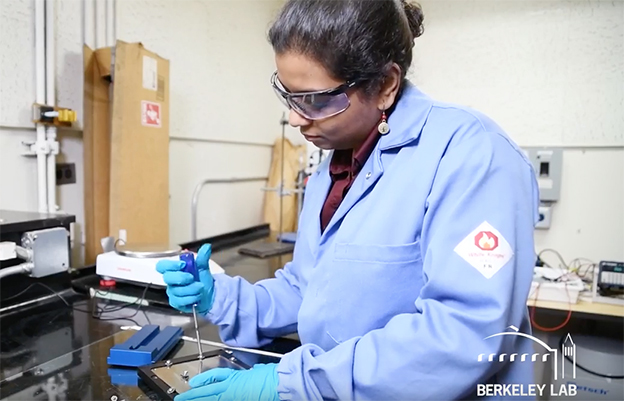View more videos about our water-energy research here.
Recognizing that the issues of water and energy are critically interdependent, the Department of Energy’s Lawrence Berkeley National Laboratory (Berkeley Lab) is launching a new research institute to focus resources on its growing portfolio of projects for water innovation.
Building on a decades-long tradition of “team science,” Berkeley Lab’s Water-Energy Resilience Research Institute (WERRI) will house a gamut of research, from nano-engineered desalination solutions to ultra-high resolution climate modeling for watershed predictions to novel groundwater management approaches.
“Berkeley Lab has a strong foundation in fundamental science, materials science, and systems modeling, all things that are absolutely critical to advancing water technology,” said WERRI Director Peter Fiske, who was hired by Berkeley Lab last year to lead the water-energy initiative. “And our location in California – and proximity to many of the leading research universities and major water utilities in the area – give us the opportunity to develop innovative research programs that are oriented to practical applications and concrete results.”
Billions of gallons of water are used each day in the United States for energy production, and huge amounts of energy are consumed in pumping, treating, heating, and delivering water. “The DOE has realized that water and energy are inextricably linked,” Fiske said. “More than 12 percent of the energy used in the U.S. is for water production, and water is a substantial limiter on energy production. So it makes sense for the two problems to be looked at together.”
WERRI researchers have expertise in a wide range of disciplines, from biogeochemistry and hydrology to nanoscience, economics, ecology, and computer modeling, to name a few. In addition, scientists will be able to take advantage of world-class Berkeley Lab facilities such as the Molecular Foundry and the Advanced Light Source, both DOE Office of Science user facilities, each with advanced instrumentation for scientific inquiry.
One of the top priorities for innovation is desalination. Reverse osmosis has been the state-of-the-art in water desalination for half a century. While it’s used in thousands of desalination plants around the world, the process is costly and highly energy intensive, without a lot of room left for improvement.
“There’s no free lunch left here,” said Berkeley Lab scientist Robert Kostecki. “Considering how mature the technology is, this effort is going to take a breakthrough.”
Berkeley Lab researchers are working on a number of approaches to efficiently separate salt from water, whether it’s seawater or brackish water, ranging from understanding the fundamental properties of water at the nanoscale to advanced technologies for water treatment. For example, Dan Miller is leading investigation of a membrane that can yield a higher rate of desalination while also being resistant to fouling, a major obstacle in cost-effective desalination.
And Chinmayee Subban is developing a technology that uses electrochemistry to treat brackish water, which is about one-third as saline as seawater and is prevalent in the United States and other parts of the world, largely as naturally occurring groundwater or through coastal intrusion. Water treated with this technology could be ideal for use in agricultural irrigation.
“With the portfolio of projects I think we’re covering the entire TRL [technology readiness level] scale,” Kostecki said.
Another project already underway is groundwater banking, a way to basically save rainwater for a sunny day. In collaboration with the Almond Board of California, Berkeley Lab researcher Peter Nico is testing how best to do groundwater aquifer recharge, combining ground-based and airborne techniques to get geophysical images of the subsurface.
While some of the projects are being tested and developed in California, WERRI’s ambitions extend beyond the state.
“California is a great test bed, but our vision for the Institute is indeed national,” Fiske said. “While water problems are distinctive and somewhat different from region to region, they’re all characterized by the inability to accurately predict future demand and understand how supply is going to affect economic development.”
Berkeley Lab’s expertise in energy analysis will also be put into play for understanding and optimizing water systems. For example, researchers are investigating how to reduce the energy needed for groundwater pumping and utility-scale ocean desalination.
“Berkeley Lab has pioneered the use of techno-economic analysis to predict energy utilization and to understand the contributions from energy efficiency to the overall U.S. energy portfolio,” Fiske said. “Many of these same tools can be deployed for water.”
The Berkeley Lab scientists have close working relationships with UC Berkeley researchers, especially through the U.S./China Clean Energy Research Center for Water Energy Technologies (CERC-WET) and Berkeley Water Center.
“We are delighted to see the U.S. Department of Energy recognize the critical role that water plays in energy security,” said Berkeley Water Center Co-Director David Sedlak. “WERRI comes at an important time for the state of California and the country as a whole, focusing Berkeley Lab’s world-class research capabilities on an issue of critical national need.”
The challenge is daunting, but Fiske believes Berkeley Lab can make significant headway in improving our ability to be more resilient to dryer climates.
“I am optimistic – that’s why I’m a scientist,” Fiske said. “But I recognize that important solutions will not arise unless there’s a concerted focus on developing new technologies, testing them in real world conditions, and advising the policy community about the most efficient ways to implement them.”
# # #
Lawrence Berkeley National Laboratory addresses the world’s most urgent scientific challenges by advancing sustainable energy, protecting human health, creating new materials, and revealing the origin and fate of the universe. Founded in 1931, Berkeley Lab’s scientific expertise has been recognized with 13 Nobel Prizes. The University of California manages Berkeley Lab for the U.S. Department of Energy’s Office of Science. For more, visit www.lbl.gov.
DOE’s Office of Science is the single largest supporter of basic research in the physical sciences in the United States, and is working to address some of the most pressing challenges of our time. For more information, please visit science.energy.gov.
